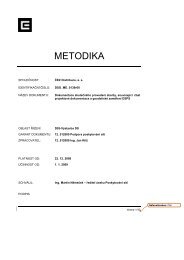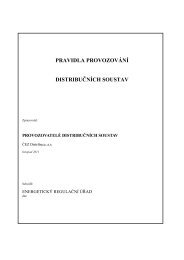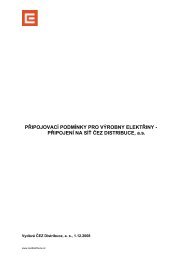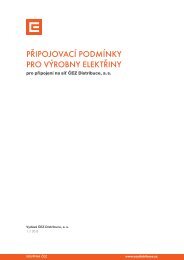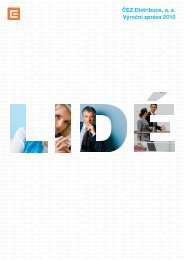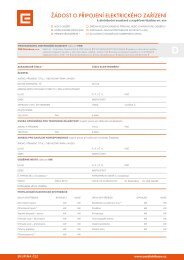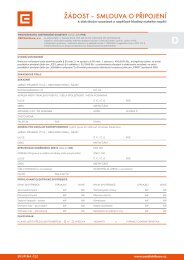012 - ÄEZ Distribuce
012 - ÄEZ Distribuce
012 - ÄEZ Distribuce
- No tags were found...
You also want an ePaper? Increase the reach of your titles
YUMPU automatically turns print PDFs into web optimized ePapers that Google loves.
ČEZ <strong>Distribuce</strong>, a. s. Notes to the Financial Statements as of December 31, 2<strong>012</strong><br />
2. Basis of Presentation of the Financial Statements<br />
The accompanying financial statements were prepared in accordance with the Czech Act on Accounting and the related<br />
guidelines as applicable for 2<strong>012</strong> and 2011.<br />
Explanation Added for Translation into English<br />
These financial statements are presented on the basis of accounting principles and standards generally accepted in the Czech<br />
Republic. Certain accounting practices applied by the Company that conform with generally accepted accounting principles<br />
and standards in the Czech Republic may not conform with generally accepted accounting principles in other countries.<br />
3. Summary of Significant Accounting Policies<br />
The accounting policies applied by the Company in preparing the 2<strong>012</strong> and 2011 financial statements are as follows:<br />
a) Intangible Fixed Assets<br />
Intangible fixed assets are recorded at their acquisition cost and related expenses and are amortized over their useful<br />
economic lives (3 years to 6 years).<br />
Since 2011, intangible fixed assets include software provided that it has been developed internally for trading purposes, or it<br />
has been acquired from other parties, irrespective of its cost. The above also applies to software licenses, if such licenses are<br />
not part of the valuation of the acquired software, or part of the technical improvement of the existing software.<br />
b) Tangible Fixed Assets<br />
Purchased tangible fixed assets with a cost exceeding CZK 20 thousand are recorded at their acquisition cost, which consists<br />
of purchase price, freight, customs duties and other related costs. Internally-developed tangible fixed assets are recorded at<br />
their accumulated cost, which consists of direct material, labor costs and production overheads.<br />
Tangible fixed assets acquired free of charge are valued at their replacement cost and are recorded with a corresponding<br />
credit to the ‘Other capital funds account’ on the date of acquisition. The costs of technical improvements are capitalized.<br />
Repairs and maintenance expenses are expensed as incurred.<br />
Depreciation<br />
Depreciation is calculated based on the acquisition cost and the estimated useful life of the related asset. The useful economic<br />
lives are as follows:<br />
Years<br />
Constructions 40–50<br />
Machinery and equipment 4–30<br />
Vehicles 4–8<br />
Furniture and fixtures 4–25<br />
061<br />
Acquisition costs and net book values of depreciated intangible and tangible fixed assets were revalued in an expert opinion as<br />
at 1 January 2010. The revaluation of acquisition costs and net book value of assets was made in connection with the merger<br />
project.<br />
c) Financial Assets<br />
Short-term financial assets consist of liquid valuables.<br />
d) Inventory<br />
Purchased inventory is stated at actual cost being determined using the weighted average method. Costs of purchased<br />
inventory include acquisition-related costs (freight, customs, commission, etc.).<br />
Finished goods and work-in-progress (services) are recorded at actual cost. Actual cost includes, in particular, direct external<br />
costs of material, manufacturing costs of relaying and cost of inventory produced internally. The cost of inventory produced<br />
internally includes direct labor costs, including overhead costs, and are allocated to work-in-progress on the basis of hours<br />
actually worked.<br />
e) Receivables<br />
Both long- and short-term receivables are carried at their realizable value after allowance for doubtful accounts. Additions to the<br />
allowance account are charged to income.<br />
f) Equity<br />
The basic capital of the Company is stated at the amount recorded in the Commercial Register maintained in the Registry<br />
Court. Any increase or decrease in the basic capital made pursuant to the decision of the General Meeting which was not<br />
entered in the Commercial Register as at the financial statements date is recorded through changes in basic capital.<br />
Contributions in excess of basic capital are recorded as share premium. Other capital funds consist of monetary and<br />
non-monetary contributions in excess of basic capital.




